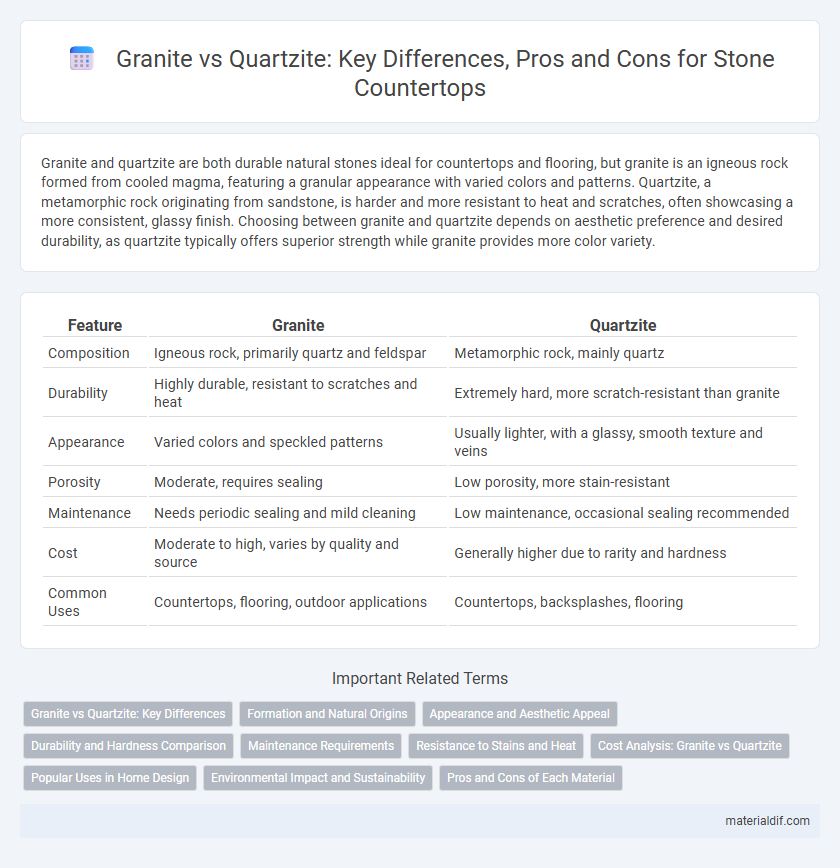Granite and quartzite are both durable natural stones ideal for countertops and flooring, but granite is an igneous rock formed from cooled magma, featuring a granular appearance with varied colors and patterns. Quartzite, a metamorphic rock originating from sandstone, is harder and more resistant to heat and scratches, often showcasing a more consistent, glassy finish. Choosing between granite and quartzite depends on aesthetic preference and desired durability, as quartzite typically offers superior strength while granite provides more color variety.
Table of Comparison
| Feature | Granite | Quartzite |
|---|---|---|
| Composition | Igneous rock, primarily quartz and feldspar | Metamorphic rock, mainly quartz |
| Durability | Highly durable, resistant to scratches and heat | Extremely hard, more scratch-resistant than granite |
| Appearance | Varied colors and speckled patterns | Usually lighter, with a glassy, smooth texture and veins |
| Porosity | Moderate, requires sealing | Low porosity, more stain-resistant |
| Maintenance | Needs periodic sealing and mild cleaning | Low maintenance, occasional sealing recommended |
| Cost | Moderate to high, varies by quality and source | Generally higher due to rarity and hardness |
| Common Uses | Countertops, flooring, outdoor applications | Countertops, backsplashes, flooring |
Granite vs Quartzite: Key Differences
Granite is an igneous rock composed mainly of quartz, feldspar, and mica, known for its durability and wide range of colors, making it a popular choice for countertops and flooring. Quartzite, a metamorphic rock formed from sandstone, offers superior hardness and resistance to heat and acid compared to granite, with a more glassy and crystalline appearance. Key differences between granite and quartzite include their formation process, hardness, and maintenance requirements, with quartzite generally being harder and more resistant to staining than granite.
Formation and Natural Origins
Granite forms through the slow crystallization of magma beneath the Earth's surface, resulting in a coarse-grained texture composed primarily of quartz, feldspar, and mica. Quartzite originates from the metamorphism of sandstone, where intense heat and pressure fuse quartz grains together, creating a dense and hard stone. Both stones showcase distinct natural origins, with granite originating from igneous processes and quartzite from metamorphic transformations.
Appearance and Aesthetic Appeal
Granite features a granular texture with a wide range of color patterns, often showcasing specks and veins that create a bold, natural appearance ideal for countertops and architectural elements. Quartzite offers a smoother, more uniform surface with subtle, flowing patterns and lighter shades, providing an elegant and timeless aesthetic favored in modern and minimalist designs. The choice between granite and quartzite depends on desired visual texture and color intensity to complement interior styles.
Durability and Hardness Comparison
Granite exhibits exceptional durability with a Mohs hardness rating of 6-7, making it highly resistant to scratches and chips. Quartzite surpasses granite in hardness, typically scoring 7 on the Mohs scale, offering superior resistance to abrasion and wear in high-traffic areas. Both stones provide long-lasting strength, but quartzite's denser composition generally grants it enhanced toughness and longevity for demanding applications.
Maintenance Requirements
Granite requires periodic sealing to protect its porous surface from stains and moisture, making regular maintenance essential. Quartzite is denser and harder, often needing less frequent sealing, which results in lower overall maintenance compared to granite. Both stones benefit from routine cleaning with pH-neutral products to preserve their natural durability and appearance.
Resistance to Stains and Heat
Granite exhibits outstanding resistance to heat, tolerating temperatures up to 1,200degF without damage, making it ideal for kitchen countertops exposed to hot pots and pans. Quartzite, while also heat resistant, tends to be slightly less tolerant than granite but still outperforms many other natural stones. Both stones possess good stain resistance due to their dense, non-porous surfaces, though sealing granite regularly ensures optimal protection against oil and acid-based stains.
Cost Analysis: Granite vs Quartzite
Granite typically costs between $40 and $100 per square foot, while quartzite ranges from $70 to $150 per square foot, influenced by availability and processing complexity. The higher price of quartzite reflects its greater hardness and durability, which can reduce maintenance expenses over time. Choosing between granite and quartzite involves balancing initial investment with long-term benefits for both residential and commercial stone applications.
Popular Uses in Home Design
Granite is widely favored for kitchen countertops and bathroom vanities due to its durability and resistance to heat and scratches, making it suitable for heavy-use areas. Quartzite is popular in home design for flooring, backsplashes, and accent walls because of its natural, marble-like appearance and high hardness, offering both aesthetic appeal and lasting strength. Both stones provide unique textures and colors, enhancing the elegance and functionality of residential interiors.
Environmental Impact and Sustainability
Granite mining and processing typically generate lower carbon emissions compared to quartzite extraction, which often demands more intensive quarrying techniques and energy use. Quartzite's natural durability reduces the need for sealants and frequent replacement, enhancing its sustainability in long-term applications. Both stones offer recyclability, but granite's widespread availability may result in less environmental strain over time.
Pros and Cons of Each Material
Granite offers superior durability and heat resistance, making it ideal for kitchen countertops but can require periodic sealing to prevent stains. Quartzite combines natural beauty with exceptional hardness and scratch resistance, though it is generally more expensive and less widely available than granite. Both materials provide distinct aesthetic appeal and long-lasting performance, requiring careful consideration of maintenance needs and budget constraints.
Granite vs Quartzite Infographic

 materialdif.com
materialdif.com